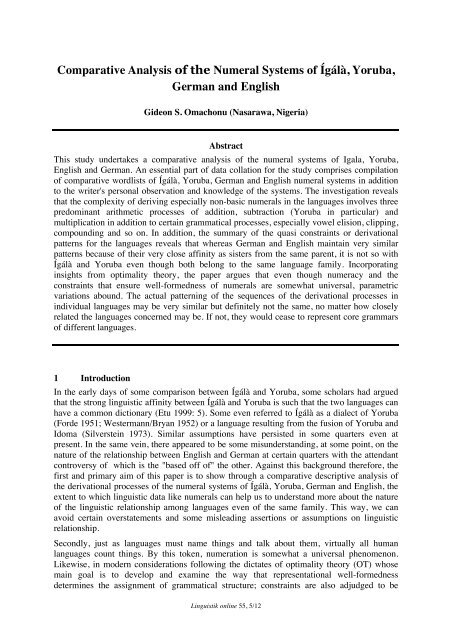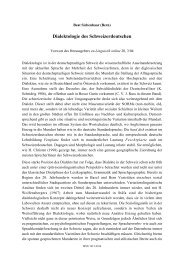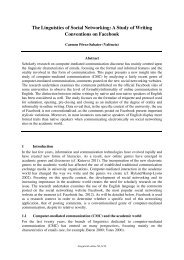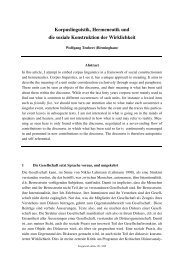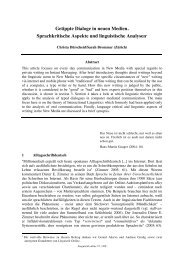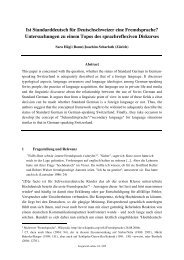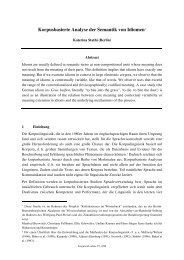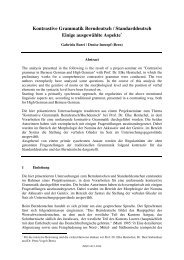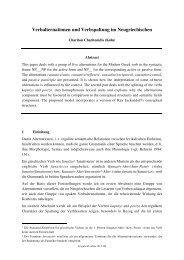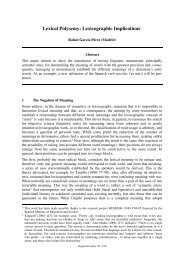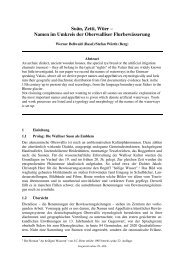Comparative Analysis of the Numeral Systems of ... - Linguistik online
Comparative Analysis of the Numeral Systems of ... - Linguistik online
Comparative Analysis of the Numeral Systems of ... - Linguistik online
You also want an ePaper? Increase the reach of your titles
YUMPU automatically turns print PDFs into web optimized ePapers that Google loves.
<strong>Comparative</strong> <strong>Analysis</strong> <strong>of</strong> <strong>the</strong> <strong>Numeral</strong> <strong>Systems</strong> <strong>of</strong> Ígálà, Yoruba,German and EnglishGideon S. Omachonu (Nasarawa, Nigeria)AbstractThis study undertakes a comparative analysis <strong>of</strong> <strong>the</strong> numeral systems <strong>of</strong> Igala, Yoruba,English and German. An essential part <strong>of</strong> data collation for <strong>the</strong> study comprises compilation<strong>of</strong> comparative wordlists <strong>of</strong> Ígálà, Yoruba, German and English numeral systems in additionto <strong>the</strong> writer's personal observation and knowledge <strong>of</strong> <strong>the</strong> systems. The investigation revealsthat <strong>the</strong> complexity <strong>of</strong> deriving especially non-basic numerals in <strong>the</strong> languages involves threepredominant arithmetic processes <strong>of</strong> addition, subtraction (Yoruba in particular) andmultiplication in addition to certain grammatical processes, especially vowel elision, clipping,compounding and so on. In addition, <strong>the</strong> summary <strong>of</strong> <strong>the</strong> quasi constraints or derivationalpatterns for <strong>the</strong> languages reveals that whereas German and English maintain very similarpatterns because <strong>of</strong> <strong>the</strong>ir very close affinity as sisters from <strong>the</strong> same parent, it is not so withÍgálà and Yoruba even though both belong to <strong>the</strong> same language family. Incorporatinginsights from optimality <strong>the</strong>ory, <strong>the</strong> paper argues that even though numeracy and <strong>the</strong>constraints that ensure well-formedness <strong>of</strong> numerals are somewhat universal, parametricvariations abound. The actual patterning <strong>of</strong> <strong>the</strong> sequences <strong>of</strong> <strong>the</strong> derivational processes inindividual languages may be very similar but definitely not <strong>the</strong> same, no matter how closelyrelated <strong>the</strong> languages concerned may be. If not, <strong>the</strong>y would cease to represent core grammars<strong>of</strong> different languages.1 IntroductionIn <strong>the</strong> early days <strong>of</strong> some comparison between Ígálà and Yoruba, some scholars had arguedthat <strong>the</strong> strong linguistic affinity between Ígálà and Yoruba is such that <strong>the</strong> two languages canhave a common dictionary (Etu 1999: 5). Some even referred to Ígálà as a dialect <strong>of</strong> Yoruba(Forde 1951; Westermann/Bryan 1952) or a language resulting from <strong>the</strong> fusion <strong>of</strong> Yoruba andIdoma (Silverstein 1973). Similar assumptions have persisted in some quarters even atpresent. In <strong>the</strong> same vein, <strong>the</strong>re appeared to be some misunderstanding, at some point, on <strong>the</strong>nature <strong>of</strong> <strong>the</strong> relationship between English and German at certain quarters with <strong>the</strong> attendantcontroversy <strong>of</strong> which is <strong>the</strong> "based <strong>of</strong>f <strong>of</strong>" <strong>the</strong> o<strong>the</strong>r. Against this background <strong>the</strong>refore, <strong>the</strong>first and primary aim <strong>of</strong> this paper is to show through a comparative descriptive analysis <strong>of</strong><strong>the</strong> derivational processes <strong>of</strong> <strong>the</strong> numeral systems <strong>of</strong> Ígálà, Yoruba, German and English, <strong>the</strong>extent to which linguistic data like numerals can help us to understand more about <strong>the</strong> nature<strong>of</strong> <strong>the</strong> linguistic relationship among languages even <strong>of</strong> <strong>the</strong> same family. This way, we canavoid certain overstatements and some misleading assertions or assumptions on linguisticrelationship.Secondly, just as languages must name things and talk about <strong>the</strong>m, virtually all humanlanguages count things. By this token, numeration is somewhat a universal phenomenon.Likewise, in modern considerations following <strong>the</strong> dictates <strong>of</strong> optimality <strong>the</strong>ory (OT) whosemain goal is to develop and examine <strong>the</strong> way that representational well-formednessdetermines <strong>the</strong> assignment <strong>of</strong> grammatical structure; constraints are also adjudged to be<strong>Linguistik</strong> <strong>online</strong> 55, 5/12
58<strong>Linguistik</strong> <strong>online</strong> 55, 5/12universal. As Prince and Smolensky (1993) have argued, universal grammar generates a set <strong>of</strong>highly general and somewhat conflicting well-formedness constraints, which are all operative,functional and attested in specific languages as core grammars. As it were, resolving <strong>the</strong>se<strong>of</strong>ten conflicting universal constraints in terms <strong>of</strong> ordering <strong>the</strong>m according to languagespecific preference is what distinguishes one language from ano<strong>the</strong>r (see also Omachonu2007). Suffice it to say that even though this study is not purely a constrained-based analysis;it incorporates insights from OT orientation into <strong>the</strong> comparative descriptive analysis <strong>of</strong> <strong>the</strong>numeral systems <strong>of</strong> Ígálà, Yoruba, German and English with a view to discovering <strong>the</strong>uniqueness <strong>of</strong> <strong>the</strong> individual languages in this respect as well as <strong>the</strong> relationship between <strong>the</strong>mas sub-sets <strong>of</strong> <strong>the</strong> universal grammar. With this, <strong>the</strong> second aim <strong>of</strong> this paper is to argue that<strong>the</strong> what, where, how and why <strong>of</strong> <strong>the</strong> derivational processes in <strong>the</strong> numeral systems <strong>of</strong> <strong>the</strong>selanguages could first be interpreted as universal imperatives for well-formedness, <strong>the</strong>individual language preference which when compared across languages could reveal <strong>the</strong>unique identity <strong>of</strong> each language.Lastly, <strong>the</strong> third focus <strong>of</strong> this study, though closely related to <strong>the</strong> first two, is to do acomparison within a comparison. This is to be achieved by comparing <strong>the</strong> summary <strong>of</strong> <strong>the</strong>derivational processes (captured in form <strong>of</strong> summation <strong>of</strong> formulae or quasi constraints foreach <strong>of</strong> <strong>the</strong> languages) between <strong>the</strong> two sets <strong>of</strong> languages (Ígálà/Yoruba vs. German/English)to see whe<strong>the</strong>r <strong>the</strong> nature <strong>of</strong> <strong>the</strong> relationship is <strong>the</strong> same for both sets or not.2 The Languages and <strong>the</strong>ir Known Relationships2.1 German and EnglishBoth German and English language, it is common knowledge; belong to <strong>the</strong> Indo-Europeanlanguages family. They were first <strong>of</strong> all, by origin, West Germanic languages, originallyspoken by <strong>the</strong> Saxons in nor<strong>the</strong>rn Germany and brought to <strong>the</strong> British Isles in <strong>the</strong> 5 th century(Pfeffer/Cannon 1994). However, <strong>the</strong>re appears to be some misunderstanding <strong>of</strong> <strong>the</strong>relationship between English and German at certain quarters. The controversy ormisunderstanding is whe<strong>the</strong>r it is English that borrowed from German or German fromEnglish considering <strong>the</strong> affinities between <strong>the</strong> two. From an informed opinion, nei<strong>the</strong>r Englishnor German is "based <strong>of</strong>f <strong>of</strong>" <strong>the</strong> o<strong>the</strong>r and it is not that <strong>the</strong>y borrowed from each o<strong>the</strong>rmutually. The truth is that <strong>the</strong> two simply come from a common ancestor known as CommonWest Germanic (CWG). This was an ancient Germanic language that split from an even moreancient Germanic language (Proto-Germanic). It eventually gave rise to Old High German,<strong>the</strong> ancestor <strong>of</strong> German and o<strong>the</strong>r High Germanic languages as well as Old Saxon which is <strong>the</strong>ancestor <strong>of</strong> Low Germanic languages, such as Dutch and Anglo-Saxon, which in turn was <strong>the</strong>direct ancestor <strong>of</strong> English (Hawkins 1986; Pfeffer/Cannon 1994; Uwalaka 2001; Crystal2010). By implication, English and German both descended from <strong>the</strong> West Germanic eventhough <strong>the</strong>ir relationship has been somewhat blurred by <strong>the</strong> great influx <strong>of</strong> Norman Frenchwords into <strong>the</strong> English lexicon consequent upon <strong>the</strong> Norman conquest <strong>of</strong> England in 1066.Even as <strong>the</strong>y went <strong>the</strong>ir separate ways, developed in different ways and with differentinfluences and grew more apart with time, <strong>the</strong>re are still many similarities between <strong>the</strong>mbecause <strong>the</strong>y come from a common root.2.2 Igala and YorubaWhereas English and German may need little or no introduction because <strong>the</strong>y are bothlanguages <strong>of</strong> wider communication with English 1 being spoken in more countries/nations <strong>of</strong>1 English is spoken natively by well over 300 million people mainly in Great Britain, <strong>the</strong> United States <strong>of</strong>America, Australia, Canada, New Zealand, Ireland and o<strong>the</strong>r parts <strong>of</strong> <strong>the</strong> world. At present, it is spoken in aboutISSN 1615-3014
Gideon S. Omachonu: <strong>Comparative</strong> <strong>Analysis</strong> <strong>of</strong> <strong>the</strong> <strong>Numeral</strong> <strong>Systems</strong> <strong>of</strong> Ígálà, Yoruba,German and English61sou<strong>the</strong>rn Nigeria, extending fur<strong>the</strong>r north in <strong>the</strong> west than in <strong>the</strong> east, and overlapping intoBenin. The largest languages in <strong>the</strong> family are Yoruba and Igbo spoken by over 20 millionand over 15 million people respectively (c. f. Grimes 1996). The list below summarizes <strong>the</strong>salient linguistic features <strong>of</strong> West Benue-Congo as culled from Williamson and Blench (2000:31):i. Noun classes: Full(Gade)/reduced (Edoid)/remnant (Yoruba); prefixesii.iii.iv.Verbal extensions: Edoid has a number (<strong>of</strong>ten indicating plurality) and Igboid many,most <strong>of</strong> which are new developments.Pronouns: Independent, subject, object, possessiveSentence order: SMVOA, SVMOA, Prepositionsv. Noun phrase: N+Gen; N+Poss; N+Adj; N+Num; N+Dem; N+DefiniteIn spite <strong>of</strong> subsequent attempts at constructing <strong>the</strong> Benue-Congo by Stewart (2002) andBlench (2004) or some languages within <strong>the</strong> Benue-Congo family by Kambon (2005) andBabaev (2008), Williamson and Blench's model remains, for now, <strong>the</strong> most recent,comprehensive and scholarly model on <strong>the</strong> table (see also Kambon 2005: 19). Consequently,very few reliable comparative works exist in <strong>the</strong> literature on this subject matter. Unlike <strong>the</strong>case <strong>of</strong> Indo-European (to which English and German belong), where total coverage has beenachieved (Kambon 2005; Babaev 2008), reconstructing <strong>the</strong> Benue-Congo still leaves much tobe desired. It is amazing that even over forty years after Greenberg's classification, <strong>the</strong> state <strong>of</strong>comparative research in Benue-Congo remains inadequate. There is clearly lack <strong>of</strong> effort asjust few people including Africanists and/or African linguists dedicate <strong>the</strong>ir studies to <strong>the</strong>comparative reconstruction <strong>of</strong> Niger-Congo and <strong>the</strong> Benue-Congo in particular. AsWilliamson (2000) has argued, even in <strong>the</strong> Niger-Congo as a whole, since <strong>the</strong> two majorattempts by Greenberg (1963, 1966) and Mukarovsky (1976–1977), no serious effort toreconstruct <strong>the</strong> Niger-Congo and by implication, <strong>the</strong> Benue-Congo has yet been made. Sheacknowledges that some <strong>of</strong> <strong>the</strong> factors responsible for <strong>the</strong> delay are (1) <strong>the</strong> vast number <strong>of</strong>languages in <strong>the</strong> group which makes it practically impossible to identify and document all <strong>the</strong>languages in <strong>the</strong> family and (2) <strong>the</strong> corresponding lack <strong>of</strong> written records or available collatedrelevant data in <strong>the</strong> languages. In o<strong>the</strong>r words, <strong>the</strong> many uncertainties and lacunae in basicdata, Williamson and Blench (2000: 41) have argued, constitute an impediment or'unfortunate limitation on any full-scale reconstruction'.Apart from <strong>the</strong> issue <strong>of</strong> inadequate attention, <strong>the</strong>re is also <strong>the</strong> problem <strong>of</strong> methodology in <strong>the</strong>available studies even from <strong>the</strong> early periods <strong>of</strong> <strong>the</strong> attempts at classification andreconstruction <strong>of</strong> African languages such as Koelle (1854), Westermann (1911, 1927),Greenberg (1963, 1966) and Mukarovsky (1976–1977). However useful <strong>the</strong>se earlierclassifications may appear, <strong>the</strong>y have failed to provide a dependable historical schema or<strong>the</strong>oretical framework for <strong>the</strong> development <strong>of</strong> <strong>the</strong> phylum as a whole hence <strong>the</strong>re have beensome attempts at revision <strong>of</strong> <strong>the</strong>se earlier grouping or classifications (c. f. Blench 2004). In<strong>the</strong> same vein, Williamson (1971: 252) observes that despite her comparative wordlists study<strong>of</strong> <strong>the</strong> Benue-Congo languages, no convincing lexical innovations were found for BC despiteits acceptance as a grouping. However, Williamson (2000) has drawn attention to <strong>the</strong> fact that<strong>the</strong> time is ripe to attempt serious reconstruction <strong>of</strong> Niger-Congo and by implication <strong>the</strong>Benue-Congo as she posits that <strong>the</strong> materials and <strong>the</strong> tools are now available for <strong>the</strong> task.3 Methods for <strong>the</strong> Present StudyData ga<strong>the</strong>ring for this study commenced with compilation <strong>of</strong> comparative wordlists <strong>of</strong> Ígálà,Yoruba, English and German numeral systems in addition to <strong>the</strong> researcher's personalobservation <strong>of</strong> <strong>the</strong> systems as a trained linguist who is a native speaker <strong>of</strong> Ígálà, speaksISSN 1615-3014
62<strong>Linguistik</strong> <strong>online</strong> 55, 5/12English as a second language and possesses some level <strong>of</strong> pr<strong>of</strong>iciency in Yoruba and German.The study handles numerals 1–1000(cardinal numbers only). The figures (numerals 1–1000)are classified into five groups as presented in tables I–V and <strong>the</strong> variables for derivations(also figures) coded using letters <strong>of</strong> <strong>the</strong> English alphabet: A represents 1–9, B represents 10(basic), C represents 20 (Basic), D represents 30, E represents 100 and F for 200. These sixvariables: A, B, C, D, E, F interact with <strong>the</strong> three relevant constraints or imperatives for wellformedness(add, subtract and multiply) to arrive at <strong>the</strong> formulae or patterns for deriving <strong>the</strong>numerals 1–1000 in each <strong>of</strong> <strong>the</strong> languages. The imperatives to add, subtract and multiplyidentified in <strong>the</strong> arithmetic processes involved in <strong>the</strong> derivations <strong>of</strong> numerals in <strong>the</strong> languageswere captured as prototype, pseudo or quasi constraints which in turn were summarized asordered by <strong>the</strong> preferences each <strong>of</strong> <strong>the</strong> languages allows. This is so arranged for <strong>the</strong> purpose<strong>of</strong> "at a glance comparison". Lastly, even though I have rendered <strong>the</strong> data from <strong>the</strong> o<strong>the</strong>r threelanguages in phonetic transcription, I have left most data from English in <strong>the</strong> orthography toserve as a guide to readers who may not have knowledge <strong>of</strong> Ígálà, Yoruba and German.4 Data Presentation and <strong>Analysis</strong>Figure Ígálà Yoruba German English1 ínyé/ókà ̣ [íɲέ/ ókà] ӗnin/òkan ̣ [ӗnĩ/ɔ̀kã] eins ['ains] one ['wʌn]2 èjì [èʤì] èjì [èʤì] zwei ['ʦvai] two ['tu:]3 è!tā [`εtā] èta ̣ [ɛ̀tā] drei ['drai] three ['θri:]4 è!lè! [`εl`ε] èrín ̣ [ɛ̀rî ] vier ['fi:a] four ['fɔ:]5 è!lú [`εlú] àrún [àrũ] fünf ['fʲünf] five ['faiv]6 èfà ̣ [`εfà] èfà ̣ [ɛ̀fà] sechs ['zɛks] six ['siks]7 èbiē [èbϳiē] èje [èʤe ] sieben ['zi:bņ] seven ['sevǝn]8 èjọ̄ ̣ [ɛ̀ʤɔ̄] èjọ ̣ [ɛ̀ʤɔ̄] acht ['axt] eight ['eit]9 è!lá [`εlá] èsan ̣ [ɛ̀sã] neun ['nɔin] nine ['nain]10 è!gʷá [`εgʷá] èwá ̣ [ɛ̀wá] zehn ['ʦɜ:n] ten ['ten]Table 1: Basic <strong>Numeral</strong>s 1–10 (1–9 = Set A)From Table I above, <strong>the</strong> numerals 1–10 are all basic forms in <strong>the</strong> four languages. Noderivation is involved. However, considering <strong>the</strong> syllable structures <strong>of</strong> <strong>the</strong> forms for 1–10 in<strong>the</strong> languages, one would discover that whereas Ígálà and Yoruba maintain a VCV,(disyllabic) open syllable structure, English has monosyllabic closed syllable structure CVCfor numerals 1, 5, 9, and 10, CVCC for 6, and VC for 8, <strong>the</strong>n monosyllabic open syllablestructure for 2, 3 and 4 while only numeral 7 is disyllabic combining both open and closedsyllable structures – CV$CVC as in ['seven]. Similarly, German also has varied syllablestructures in <strong>the</strong> forms <strong>of</strong> VCC (closed syllable) for 1 and 8, CVC for 9 and 10, CVCC for 5and 6, and open syllable structure for numerals 2(CCV), 3 and 4. Equally, numeral 7 inGerman is disyllabic combining both open and closed syllable structures in <strong>the</strong> patternCV$CVC as in ['zi:bņ].Figure Ígálà Yoruba German EnglishB + A A + B/C-A A + B A + B11 ὲgʷákà10 + 112 ὲgʷéʤì10 + 2mɔ̀kãlá1 + 10méʤìlá2 + 10'ɛlf11'ʦvœlf12i'lɛvǝn11'twɛlv1213 ὲgʷέtā10 + 3mɛ́tālá3 + 10'draiʦɜ:n3 + 10θɜ:'ti:n3 + 10ISSN 1615-3014
Gideon S. Omachonu: <strong>Comparative</strong> <strong>Analysis</strong> <strong>of</strong> <strong>the</strong> <strong>Numeral</strong> <strong>Systems</strong> <strong>of</strong> Ígálà, Yoruba,German and English6314 ὲgʷέlὲ10 + 415 ὲgʷέlū10 + 516 ὲgʷέfà10 + 617 ὲgʷébjiē10 + 718 ὲgʷέʤɔ̄10 + 819 ὲgʷέlā10 + 9mɛ́rîlá4 + 10mɛ́ɛ̀ɛ́dógṹ-5 + 20mɛ́rîdîlógṹ4 from 20mɛ́tàdîlógṹ3 from 20méʤìdîlógṹ2 from 20mɔ̀kãdîlógṹ1 from 20'firʦɜ:n4 + 10'fynfʦɜ:n5 + 10'zɛçʦɜ:n6 + 10'zi:pʦɜ:n7 + 10'axʦɜ:n8 + 10'nɔinʦɜ:n9 + 10Table 2: <strong>Numeral</strong>s 11–19 Derivedfɔ:'ti:n4 + 10fif'ti:n5 + 10siks'ti:n6 + 10sevǝn'ti:n7 + 10ei'ti:n8 + 10nain'ti:n9 + 10Preference in form <strong>of</strong> quasi constraints or formulae for deriving numerals in <strong>the</strong>languagesÍgálà: B + A >> 3 A + B >> A + B/C-AYoruba: A + B/C-A >> B + AGerman: A + B >> B + A >> A + B/C-AEnglish: A + B >> B + A>> A + B/C-AIn table 2, numerals 11 and 12 for both German and English appear to be basic because <strong>the</strong>yare nei<strong>the</strong>r derived through addition nor multiplication. But for Ígálà, <strong>the</strong> numerals 11 through19 are all derived using addition with base 10. Similarly from numerals 13 through 19 forGerman and English (including Ígálà), <strong>the</strong> derivations involve only addition with base 10.However, <strong>the</strong> difference between Ígálà and <strong>the</strong> o<strong>the</strong>r two (German and English) here is thatwhereas it adds <strong>the</strong> lower figures 1–9 to base 10, <strong>the</strong> o<strong>the</strong>rs add 10 to <strong>the</strong> lower figures (see<strong>the</strong> derivation <strong>of</strong> numerals 13–19 in <strong>the</strong> table above). Contrary to <strong>the</strong> above, Yoruba presentssomewhat more complex derivation processes <strong>of</strong> using conventional terms such as lé nί…(increase by/more than) and ó dίn…/dίn niί… (it reduces/reduces) to derive 11–14 and 15–19respectively. Through <strong>the</strong> use <strong>of</strong> <strong>the</strong>se terms, 11–14 and 15–19 are derived thus (see alsoOyebade 2010 and Babarinde forthcoming):11 = Mókànlélẹ́wàá = mókànlá 'one more than ten'12 = Méjὶlélẹ́wàá = méjὶlá 'two more than ten'13 = Mẹ́tàlẹ́lẹwàá = mẹ́tàlá 'three more than ten'14 = Mẹ́rinlẹ́lẹwàá = mẹ́rinlá 'four more than ten'15 = mú-árùn-dίn-nί-ogún = mẹ́ẹ̀dógún 'twenty lesser than five'16 = mú- ẹ́rin-dίn-nί-ogún = mẹ́riǹdίnlógún 'twenty lesser than four'17 = mú- ẹ̀tà -dίn-nί-ogún = mẹ́tàdίnlogún 'twenty lesser than three'18 = mú- éjì -dίn-nί-ogún = méjìdίnlogún 'twenty lesser than two'19 = mú-ọ̀kan-dίn-nί-ogún = mọ́kàndίnlógún 'twenty lesser than one'A careful observation <strong>of</strong> <strong>the</strong> data above would reveal both clipping and ellipsis atmorphological and syntactic levels <strong>of</strong> analysis respectively. This is because <strong>the</strong> derivation <strong>of</strong><strong>the</strong> numerals 11–19 in Yoruba involves some phrasal and or full sentential expressions.Besides, <strong>the</strong> presence <strong>of</strong> <strong>the</strong> lateral approximant /l/ in 16–19 is a process <strong>of</strong> phonological3 Whereas '+' and ‘^x' stand for addition and multiplication respectively, >> (left-to- right) represents derivationorder preference to show that a language prefers <strong>the</strong> sequence on <strong>the</strong> left to <strong>the</strong> one(s) to <strong>the</strong> right.ISSN 1615-3014
66<strong>Linguistik</strong> <strong>online</strong> 55, 5/12complex derivations, e. g., subtractions involving àádɔ́tā (10 removed 60) for 50, àádɔ́rĩ (10removed 80) for 70 and àádɔ́rũ-ṹ (10 removed 100) for 90 and multiplication for 40 (ogóʤì),60 (ɔgɔ́tā) and 80 (ɔgɔ́rĩ) derived by multiplying base 20 by 2, 3 and 4 respectively. But forGerman and English, it is simply by multiplying <strong>the</strong> lower figures 3–9 by base 10 consistentlyto derive 30, 40, 50, 60, 70, 80, and 90 respectively. However, it is to be noted that <strong>the</strong>derivations for Yoruba numerals have become so increasingly complex and complicated herethat our earlier schema <strong>of</strong> using letters to represent numerals could no longer accommodate<strong>the</strong>m hence <strong>the</strong> representation <strong>of</strong> actual figures (60, 80, 100) as reflected in Table 4 above.However, it is to be noted that multiplication starts at 40 in both Yoruba and Igala (see alsoTable 4).Figure Ígálà Yoruba German EnglishC x A x A F x A (- E) A x E A x E100 ógʷúmέlū/ɔ̀gbɔ̀mɛ́lū20 x 5200 ógʷúmέlūméʤì/ɔ̀gwá6 /ɔ̀gwɔ́kɔ́ (20 x 5 ) x 2300 ógʷúmέlūmɛ́tā(20 x 5) x 3400 ógʷúmέlūmɛ́lɛ̀(20 x 5) x 4500 ógʷúmέlūmέlū(20 x 5) x 5600 ógʷúmέlūmɛ́fà(20 x 5) x 6700 ógʷúmέlūmébiē(20 x 5) x 7800 ógʷúmέlūέʤɔ̄ /íʧámù 7(20 x 5) x 8900 ógʷúmέlūmɛ́lā(20 x 5) x 91000 íʧámùɲɔ́gwɔkɔ(800 + 200)ɔgɔ́rṹ-ṹ20 x 5igbā200 (basic)oodunrṹ300 (basic)irĩwó400 (basic)eedɛgbɛ̀ta100 from (200× 3)ɛgbɛ̀ta200× 3eedɛgbɛ̀rĩ ́100 from (200×4)ɛgbɛ̀rĩ ́200 × 4eedɛgbɛ̀rṹ100 from (200×5)ɛgbɛ̀rṹ200x5'ainhʊndɐt1x100'ʦvaihʊndɐt2 x 100'draihʊndɐt3 x 100'fi:ahʊndɐt4 x 100fʲünfhʊndɐt5 x 100'zɛkshʊndɐt6 x 100'zi:bņhʊndɐt7 x 100'axt hʊndɐt8 x 100'nɔinhʊndɐt9 x 100aintauzņt1x 1000Table 5: <strong>Numeral</strong>s 100, 200, 300, 400, 500, 600, 700, 800, 900, 1000one hundred1x100two hundred2 x 100three hundred3 x 100four hundred4 x 100five hundred5 x 100six hundred6 x 100seven hundred7 x 100eight hundred8 x 100nine hundred9 x 100one thousand1x1000Preference in form <strong>of</strong> quasi constraints or formulae for deriving numerals in <strong>the</strong>languagesÍgálà: C x A x A >> F x A (- E) >> A x EYoruba: F x A (- E) >> C x A x A >> A x EGerman: A x E >> C x A x A>> F x A (- E)English: A x E >> C x A x A>> F x A (- E)As could be observed from Table 5 above , for numeral 'hundred', whereas German andEnglish have basic forms that look very much alike; 'hundert' [hʊndɐt] and 'hundred'6 The numeral 200 in Ígálà has three acceptable forms; <strong>the</strong> derived (ógwú-mé!lū mé!jì, 20 x 5 x 2), ò!gwó!kó andò!gwá.7 The numeral 800 has two acceptable forms in Ígálà. It has a derived form, ógwú-!mé!lū mé!jō (20 x5 x 8) and abasic or unitary form, íchámù meaning 800 also.ISSN 1615-3014
Gideon S. Omachonu: <strong>Comparative</strong> <strong>Analysis</strong> <strong>of</strong> <strong>the</strong> <strong>Numeral</strong> <strong>Systems</strong> <strong>of</strong> Ígálà, Yoruba,German and English67respectively, <strong>the</strong> Ígálà numeral for hundred goes through a derivation process <strong>of</strong> multiplyingbase 20 by 5 to arrive at one hundred (ógʷúmέlū/ɔ̀gbɔ̀mɛ́lū). Similarly, for 200–900, <strong>the</strong>derivation process involves double multiplication by first multiplying base 20 by 5 to arrive ata hundred, and <strong>the</strong>n multiplying <strong>the</strong> hundred by a lower figure (2–9) to arrive at <strong>the</strong> number <strong>of</strong>hundreds required (see <strong>the</strong> derivations <strong>of</strong> 200–900 for Ígálà on Table 5 above). Yoruba sharesa very similar experience with Ígálà on <strong>the</strong> derivation <strong>of</strong> 100. <strong>Numeral</strong>s 200, 300 and 400 arebasic in Yoruba. <strong>Numeral</strong>s 500, 700, and 900 are derived through a combination <strong>of</strong>subtraction and multiplication whereas numerals 600, 800 and 1000 are derived bymultiplying 200 by 3, 4, and 5 respectively. For German and English, it is singlemultiplication event <strong>of</strong> multiplying <strong>the</strong> lower basic figures 1–9 by a hundred to arrive at <strong>the</strong>number <strong>of</strong> hundreds required. Again, for numeral 'thousand' while German and English havebasic forms that look very much alike also; 'tausend'[tauzņt] and 'thousand' respectively, inÍgálà, deriving a thousand goes through adding 200 (ɔ̀gwɔ́kɔ́) to 800 (íʧámù) which is read asíʧámùɲɔ́gwɔkɔ (800 + 200) to derive a thousand in Ígálà.All said and done, we present below a summary <strong>of</strong> <strong>the</strong> quasi constraints, if you like, formulaeneeded to derive numerals 10–100 (cardinal numbers only) in Ígálà and Yoruba, and 13–1000(cardinal numbers only) in German and English as captured in Tables 2–5 above recalling that<strong>the</strong> letters A, B, C, D, E and F represent numerals and <strong>the</strong> arithmetic symbols or signs: +, -and x stand for <strong>the</strong> imperatives to add, subtract and multiply respectively. Thus, we have <strong>the</strong>following configurations for <strong>the</strong> languages as tabulated below:Language Table 2 Table 3 Table 4 Table 5Ígálà B + A C + A C+B, C x A(B) C x A x AYoruba A + B/C-A A + C, -5+D/D-A C x A/-B+ 60, -B+ 80, -B+ 100 F x A (- E)German A + B A+A x B A x B A x EEnglish A + B A x B+A A x B A x ETable 6: SummaryIt is to be noted that <strong>the</strong> use <strong>of</strong> slashes as can be observed in Tables 2 and 3 for Yoruba (A +B/C-A and -5+D/D-A) shows that <strong>the</strong> two formulae so joined can both apply within <strong>the</strong>contexts but restricted to selected data respectively while <strong>the</strong> use <strong>of</strong> paren<strong>the</strong>sis as indicatedfor Ígálà (C x A (B)) and Yoruba (F x A (- E)), as usual, denotes optionality (c. f.Tables 4 and5). In all, even a quick glance at <strong>the</strong> summaries as tabulated above would reveal that,compared to German and English, Ígálà and Yoruba have more complex numeral systemswith Yoruba being much more complex. Again, whereas <strong>the</strong> individual preferences for Ígálàand Yoruba differ radically from each o<strong>the</strong>r, for German and English, <strong>the</strong>y prefer each o<strong>the</strong>r'spreferred set <strong>of</strong> constraints to <strong>the</strong> extent that <strong>the</strong> ordering is almost <strong>the</strong> same all throughexcept on one spot (see Table 3). Even <strong>the</strong>n, it is marginal. The close affinity betweenGerman and English as languages not just <strong>of</strong> <strong>the</strong> same linguistic family but sisters from <strong>the</strong>same parent or descendants <strong>of</strong> <strong>the</strong> same ancestor explains <strong>the</strong> reason for this scenario (See <strong>the</strong>section on <strong>the</strong> relationship between German and English). Even at that, <strong>the</strong>y are notcompletely identical or so identical to <strong>the</strong> extent that <strong>the</strong> grammar <strong>of</strong> one can be substitutedfor <strong>the</strong> o<strong>the</strong>r hence <strong>the</strong> variations, however minute, in <strong>the</strong>ir preferences shown above. Forinstance, where German has A+A x B, English prefers A x B+A instead (See Table 3 also).5 Summary <strong>of</strong> Findings and DiscussionFrom our analysis <strong>of</strong> <strong>the</strong> numerals so far, 1–10 in Table I above all appear to be basic forms in<strong>the</strong> four languages. No derivation is involved except that whereas Ígálà and Yoruba maintainISSN 1615-3014
68<strong>Linguistik</strong> <strong>online</strong> 55, 5/12a VCV, (disyllabic) open syllable structure for <strong>the</strong> words representing <strong>the</strong> numerals, Englishand German have varied syllable structures (monosyllabic closed/open syllable structure, anddisyllabic combining both open and closed syllable structures (CV$CVC)). In addition,whereas numerals 11 and 12 for both German and English appear to be basic <strong>the</strong>y are derivedin Ígálà and Yoruba. The numerals 11 through 19 in Ígálà are all derived using addition with10 as <strong>the</strong> base. Similarly, numerals 13 through 19 for German and English are derivedemploying only addition using base 10 also. But for Yoruba, <strong>the</strong> derivations <strong>of</strong> 11–19 takes acombination <strong>of</strong> addition and subtraction; addition to base 10 to derive 11–14 and subtractionfrom base 20 to derive 15–19 using some conventional terms as discussed earlier under Table2. Here, Ígálà tends to align more with English and German than Yoruba. However, while <strong>the</strong>coming toge<strong>the</strong>r <strong>of</strong> <strong>the</strong> words that represent <strong>the</strong> figures to be added involves phonologicalprocesses such as vowel elision in Ígálà and Yoruba, and phonological alternation in Yoruba,it is not so with German and English.Fur<strong>the</strong>rmore, <strong>the</strong> numeral 20 ógwú and oɡṹ in Ígálà and Yoruba respectively are basicwhereas <strong>the</strong>ir equivalents in German and English are derived by multiplying base 10 by 2(tsvantsiç 2 X 10, twenty2 X 10) respectively. Besides, even though numerals 21–29 for all<strong>the</strong> languages are derived, <strong>the</strong> patterns and sequences <strong>of</strong> <strong>the</strong> derivational processes are not <strong>the</strong>same.However, Yoruba employs a more complex derivation process above all by first adding <strong>the</strong>lower numerals 1–4 only to base 20 to derive 21–24, <strong>the</strong>n changes to subtraction to derive 25–29 by subtracting <strong>the</strong> lower figures 1–5 from 30 to derive 25–29. For 25 in particular, itemploys even a much more complex process as it combines both addition and subtraction.Overall, while Ígálà, Yoruba and German show overt expressions <strong>of</strong> conjunctions in <strong>the</strong> forms<strong>of</strong> -ɲókē- (Ígálà), léló/dîló (addition/subtraction in Yoruba) and -und- (German) to express <strong>the</strong>addition and or subtraction as is <strong>the</strong> case in Yoruba to derive 21–29, it is not so with English.Similarly, <strong>the</strong> derivation <strong>of</strong> <strong>the</strong> numeral 30 (ógʷɛ́gʷā) in Ígálà is effected by simply addingbase 10 to base 20 to derive 30. The form for numeral 50 (óójē [óóʤē]) is basic in Ígálà andhas no such derivation history in <strong>the</strong> language but <strong>the</strong> forms for numerals 70(ɛ̀tɛ̀gʷá) and 90(ɛ̀lɛ̀gʷá) combine both addition and multiplication in <strong>the</strong>ir derivations. As usual, apart fromɔɡbɔ̃ (30) which could be said to be basic, Yoruba presents some complex derivations, e. g.,subtraction involving àádɔ́tā (10 removed 60) for 50, àádɔ́rĩ (10 removed 80) for 70 andàádɔ́rũ-ṹ (10 removed 100) for 90 and multiplication for 40 (ogóʤì), 60 (ɔgɔ́tā) and 80 (ɔgɔ́rĩ)derived by multiplying base 20 by 2, 3 and 4 respectively. For German and English, <strong>the</strong>derivations are achieved by simply multiplying <strong>the</strong> lower figures 3–9 by base 10 consistentlyto derive 30, 40, 50, 60, 70, 80, and 90 respectively. Lastly, for numerals 'hundred' and'thousand' while German and English have basic forms that look very much alike, <strong>the</strong> Ígálànumeral for hundred goes through a derivation process <strong>of</strong> multiplying base 20 by 5 to arrive atone hundred and for a thousand, it goes through adding 200 (ɔ̀gwɔ́kɔ́) to 800 (íʧámù) which isread as íʧámùɲɔ́gwɔkɔ (800 + 200) to represent a thousand. Yoruba shares a very similarexperience with Ígálà on <strong>the</strong> derivation <strong>of</strong> 100. <strong>Numeral</strong>s 200, 300 and 400 are basic inYoruba. <strong>Numeral</strong>s 500, 700, and 900 are derived through a combination <strong>of</strong> subtraction andmultiplication whereas numerals 600, 800 and 1000 are derived by multiplying 200 by 3, 4,and 5 respectively.In all, <strong>the</strong> complexity <strong>of</strong> deriving especially non-basic numerals in <strong>the</strong> languages involvesaddition, subtraction (Yoruba, to be precise) and multiplication as well as certain grammaticalprocesses (phonological modifications, morphological and syntactic processes) such as vowel/consonant deletion, sound mutation, compounding, clipping, blending (e. g. Ígálà, ɛ̀tɛ̀gʷá (70)ISSN 1615-3014
70<strong>Linguistik</strong> <strong>online</strong> 55, 5/12(60, 80, 100) as reflected in Table IV above. Hurford (1975: 211) also experienced a similarproblem in an attempt to capture <strong>the</strong> Yoruba numeral system in a descriptive framework. Inhis own words:Yoruba has what is probably <strong>the</strong> most unusual and complicated <strong>of</strong> any <strong>of</strong> <strong>the</strong> world's naturallanguage numeral systems. This presents a number <strong>of</strong> problems for <strong>the</strong> descriptive frameworkwe have developed so far in this study and some <strong>of</strong> <strong>the</strong>se problems are quite serious.This is so because as he argues fur<strong>the</strong>r, subtraction is rarely used extensively throughout <strong>the</strong>whole numeral system by even a few languages that use it but Yoruba as he describes it, is "aspectacular exception to this general rule…" The <strong>the</strong>oretical implication <strong>of</strong> this is that<strong>the</strong>orists find it a bit difficult to develop a <strong>the</strong>oretical framework that can adequately capture<strong>the</strong> Yoruba numeral system because <strong>of</strong> its unique complexity.Over with Yoruba, even though not much has been done on Ígálà in this aspect yet,Omachonu's (2011) comprehensive study <strong>of</strong> Ígálà numeral system where <strong>the</strong> numerals wereclassified into basic and non-basic (derivatives) whose derivations involve combining <strong>the</strong>basic numerals through some addition, multiplication or a combination <strong>of</strong> both processesequally agrees with <strong>the</strong> results <strong>of</strong> <strong>the</strong> present analysis on Igala. In addition, similar findingshave been made in <strong>the</strong> previous studies <strong>of</strong> <strong>the</strong> numeral systems <strong>of</strong> o<strong>the</strong>r languages. Forinstance, in Òḳọ, Atoyebi (n. d.) observes that <strong>the</strong> complexity <strong>of</strong> deriving especially non-basicnumerals involves subtraction, multiplication and addition. In Koring, Anagbogu (2006) notesthat <strong>the</strong> derivation <strong>of</strong> most secondary numerals involves addition using overtly expressedconjunction or addition morpheme while multiplication, if any, is merely implied in <strong>the</strong>context. A reference to some <strong>of</strong> <strong>the</strong>se findings through implied comparison would help us toappreciate <strong>the</strong> importance <strong>of</strong> this kind <strong>of</strong> research as it relates to typological considerations aswell as universality <strong>of</strong> <strong>the</strong> grammar <strong>of</strong> numeracy in languages. The fact that some <strong>of</strong> <strong>the</strong>selanguages did not show overt use <strong>of</strong> certain arithmetic processes like subtraction and divisiondoes not rule out completely <strong>the</strong> possibility <strong>of</strong> <strong>the</strong>ir applicability. For instance, a deeper searchinto <strong>the</strong> numeral system <strong>of</strong> Ígálà would reveal subtraction and division especially whencounting money and fractions like half, quarter, as well as expressions such as less than andgreater than are involved. For example, <strong>the</strong> expression; 'ὲlú ʧi èʤì' (minus five from two) and'εlú ʧi ὲlὲ' (minus five from four) in Ígálà would mean seventy naira and one hundred and fiftynaira respectively where èʤì would represent iṕaḿù8 ɔ̀ gbɔ̀ méʤì (₦80) and ὲlὲ representingípámù ɔ̀ gbɔ̀ mɛ́ lɛ̀ (₦160) whereas ὲlú (5) stands for ípámù mέlū (₦10); accordingly, ₦80-₦10= ₦70 and ₦160-₦10 = ₦150. In <strong>the</strong> same vein, two hundred naira in Ígálà is 'àkpúlù kà' (onesack/bag <strong>of</strong> money), <strong>the</strong>refore to count one hundred naira, <strong>the</strong> Ígálàs would say ùpké rú ̣àkpúlù, meaning half <strong>of</strong> àkpúlù, that is, <strong>the</strong> imperative to divide àkpúlù into two equal halves.It may be plausible to say that a deeper investigation into <strong>the</strong> numeral systems <strong>of</strong> o<strong>the</strong>rlanguages would reveal similar expressions.6 Summary and ConclusionNumeracy, it should be noted, is a very important aspect <strong>of</strong> any linguistic system. Countingand or numbering is an integral and inseparable part <strong>of</strong> <strong>the</strong> grammar <strong>of</strong> any language because<strong>the</strong>re is hardly any meaningful linguistic discourse in a language that does not make referenceto quantity, size, time, distance and weight in definite numbers (Omachonu 2011: 84). Withthis, numeral system can serve as a more au<strong>the</strong>ntic source <strong>of</strong> evaluation in any linguisticsystem. Also, as it has been argued (see Hurford 1975), if we are interested in discoveringlinguistic affinity/relationship or universals, or ‘what forms <strong>of</strong> statements must be available8 The word ípámù is borrowed from <strong>the</strong> British pounds sterling to stand for two naira in Ígálà.ISSN 1615-3014
Gideon S. Omachonu: <strong>Comparative</strong> <strong>Analysis</strong> <strong>of</strong> <strong>the</strong> <strong>Numeral</strong> <strong>Systems</strong> <strong>of</strong> Ígálà, Yoruba,German and English71for a general and explanatory account <strong>of</strong> any language’ (87), <strong>the</strong> most useful, dependable andpowerful light is shed by a consideration <strong>of</strong> <strong>the</strong> numeral systems.Thus far, incorporating insights from optimality <strong>the</strong>ory, <strong>the</strong> paper has argued that even thoughnumeration and <strong>the</strong> constraints or imperatives that ensure well-formedness <strong>of</strong> numerals aresomewhat universal, parametric variations abound. The actual ordering or patterning <strong>of</strong> <strong>the</strong>sequences <strong>of</strong> <strong>the</strong> derivational processes in individual languages may be very similar as foundbetween English and German yet not definitely <strong>the</strong> same, no matter how closely related <strong>the</strong>languages concerned may be. If not, <strong>the</strong>y cease to represent core grammars <strong>of</strong> two differentlanguages.However, in spite <strong>of</strong> <strong>the</strong> parametric variations as it affects <strong>the</strong> individual languages as coregrammars deriving from <strong>the</strong> universal, <strong>the</strong>re is yet evidence <strong>of</strong> greater affinity between somelanguages than <strong>the</strong> o<strong>the</strong>rs. Hence judging from <strong>the</strong> evidence available to us from this study,<strong>the</strong>re is a greater level <strong>of</strong> affinity between English and German compared to that betweenÍgálà and Yoruba. Consequently, unlike <strong>the</strong> very close relationship between German andEnglish as co-descendants from a common ancestor known as Common West Germanic(CWG), that between Ígálà and Yoruba is not as close, let alone referring to <strong>the</strong> two asdialects <strong>of</strong> <strong>the</strong> same language. So far, whereas <strong>the</strong> relationship between English and Germanis already very clear in <strong>the</strong> literature, what comes closer to a more tenable and or acceptableexplanation, as noted earlier, are attempts by Akinkugbe (1976, 1978) at an internal linguisticclassification and comparative study <strong>of</strong> <strong>the</strong> ‘Yoruboid' where she argued that Ígálà is nei<strong>the</strong>r adialect <strong>of</strong> Yoruba nor a language resulting from <strong>the</strong> fusion <strong>of</strong> Yoruba and Idoma as claimedby Silverstein (1973) but ra<strong>the</strong>r a language that shares with Yoruba a "common ancestor" thatwas nei<strong>the</strong>r Yoruba nor Ígálà but a Proto-Yoruba- Ígálà. This present study agrees with thisposition as it validates Akinkugbe's claim with au<strong>the</strong>ntic linguistic data from numeral systems<strong>of</strong> Igala and Yoruba in this regard. However, <strong>the</strong> question to ask is what <strong>the</strong> relationship waslike before Akinkugbe (1976, 1978) and <strong>the</strong> subsequent internal classifications or attempts atreconstructions? (See section 2.3 above for detailed analysis).Overall, taking <strong>the</strong> four languages at once, one would notice that whereas <strong>the</strong>re is a greaterlinguistic affinity between English and German (Indo-European, Germanic) than betweenÍgálà and Yoruba (West Benue Congo, Yoruboid), <strong>the</strong>re is however no such relationshipbetween ei<strong>the</strong>r <strong>of</strong> <strong>the</strong> two with ei<strong>the</strong>r Ígálà or Yoruba. The same is also true <strong>of</strong> Ígálà andYoruba (Yoruboid) in relation to ei<strong>the</strong>r English or German. The only connection, one canrightly observe is <strong>the</strong> fact that <strong>the</strong> four (as paired into two groups) are living languages whichform parts <strong>of</strong> <strong>the</strong> universal system. It is hoped that this awareness would help us to avoidcertain overstatements and some misleading assertions and or assumptions on linguisticrelationships among languages. Besides, this may be a wake-up call to African linguists andresearchers on Niger-Congo or <strong>the</strong> Benue-Congo in particular for serious efforts at a full-scalereconstruction <strong>of</strong> <strong>the</strong> phylum which, according to Williamson (2000), is yet to be achieved.ReferencesAbimbola, Wande (1978): "The Yoruba traditional religion in Brazil: problems andprospects". In: Oyelaran, Olasope (ed.) (1978): Department <strong>of</strong> African languages andliteratures seminar series I. Ile-Ife: Department <strong>of</strong> African Languages and Literatures,Obafemi Awolowo University: 1–64.Abraham, Roy Clive (1958): Dictionary <strong>of</strong> modern Yoruba. London: Cambridge UniversityPress.Adewole, Lawrence Olufemi (2007): "Issues in linguistics and Yoruba language". SeminarSeries. Ile-Ife.Akinkugbe, Oluf (1976): "An internal classification <strong>of</strong> <strong>the</strong> Yoruboid group (Yoruba, Itsekiri,Igala)". The journal <strong>of</strong> West African languages XI, 2 :1–19.ISSN 1615-3014
72<strong>Linguistik</strong> <strong>online</strong> 55, 5/12Akinkugbe, Oluf (1978): A comparative phonology <strong>of</strong> Yoruba (dialects), Itsekiri and Igala.Unpublished Ph.D Thesis, Department <strong>of</strong> Linguistics and African Languages, University<strong>of</strong> Ibadan.Armstrong, Robert G. (1951): GALA: a preliminary report with word list. Institute <strong>of</strong> AfricanStudies, University <strong>of</strong> Ibadan.Anagbogu, Philip (2006): "The numerical system <strong>of</strong> Koring: an analysis". Awka journal <strong>of</strong>linguistics and languages (AJILL) 2: 71–75.Atoyebi, Joseph Dele.: Oko numerals and <strong>the</strong>ir derivation. PhD Seminar Paper, Department<strong>of</strong> Linguistics. MPI. EVA, Leipzig, Germany.Awobuluyi, Oladele (1992): "Aspect <strong>of</strong> contemporary standard Yoruba in dialectologicalperspective". In: Akinwumi, Isola (1992) (ed.) (1992): New findings in Yoruba studies.Ibadan: 5–79.Babaev, Kirill V. (2008): "Reconstructing Benue-Congo person marking I: Proto-Bantoid".Journal <strong>of</strong> West African languages XXXV/1–2: 131–190.Babarinde, Oluwasanmi. (forthcoming): "The linguistic analysis <strong>of</strong> <strong>the</strong> structure <strong>of</strong> <strong>the</strong>Yoruba counting system". In: Ndimele, Ozo-Mekuri. (ed.) (forthcoming): <strong>Numeral</strong> systems<strong>of</strong> Nigerian languages. Port Harcourt: M & J Grand Orbit Communications Ltd. & EmhaiPress.Bennett, Patrick R./Sterk, Jan P. (1977): "South-Central Niger-Congo: a reclassification".Studies in African linguistics 8/3: 241–273.Blench, Roger (2004): The Benue-Congo Languages: a Proposed Internal Classification.Manuscript available at http://www.rogerblench.info/Language/Niger-Congo/BC/General/Benue-Congo%20classification%20latest.pdf, accessed September 15,2012.Comrie, Bernard (2005): "<strong>Numeral</strong> bases". In: Haspelmath, Martin et al. (eds.) (2005): Theworld atlas <strong>of</strong> language structures. Oxford, Oxford University Press: 530–533.Comrie, Bernard (2006): Endangered numeral systems. Paper presented at Max PlanckInstitute for Evolutionary Anthropology, Leipzig and University <strong>of</strong> California, SantaBarbara.Connel, Bruce (1998): "Classifying River Cross". In: Maddieson, Ian/Hinnebusch, Thomas(eds.) (1998): Language, History and Linguistic Description in Africa. Lawrenceville:Africa World Press: 17–25.Crystal, David ( 3 2010): The Cambridge encyclopedia <strong>of</strong> language. Cambridge: CambridgeUniversity Press.Etu, Yusufu (1999): Igala expression and historical landmarks. Lokoja: Enenyo Publishers.Fábùnmi, Felix A. (2010): "Vigesimal numerals on Ifẹ̀ (Togo) and Ifẹ̀ (Nigeria) dialects <strong>of</strong>Yorùbá". <strong>Linguistik</strong> <strong>online</strong> 43, 3/10: 32–44.Forde, Cyril D. (1951): The Yoruba-speaking peoples <strong>of</strong> South-western Nigeria. WesternAfrica part IV. London: International African Institute.Gerhardt, Ludwig (1989): "Kainji and Platoid". In: Bendor-Samuel, John (ed.) (1989): AfricanLanguages. An Introduction. Cambridge, Cambridge University Press: 359–376.Greenberg, Joseph (1963/66): The languages <strong>of</strong> Africa. The Hague: Mouton for IndianaUniversity.Grimes, Barbara F. ( 13 1996): Ethnologue: languages <strong>of</strong> <strong>the</strong> world. Dallas: SIL and <strong>the</strong>University <strong>of</strong> Texas at Arlington.Hawkins, John A. (1986): A comparative typology <strong>of</strong> English and German: unifying <strong>the</strong>contrasts. Berlin: Croom Helm.Hunt, Carl M. (1977): Oỵoṭunji village: Yoruba movement in America. PhD Dissertation,West Virginia University.Hurford, James R. (1975): The linguistic <strong>the</strong>ory <strong>of</strong> numerals. Cambridge: CambridgeUniversity Press.Johnson, Samuel (1921): A history <strong>of</strong> <strong>the</strong> Yorubas. Lagos.Johnston, Harry (1919–1922): A <strong>Comparative</strong> Study <strong>of</strong> <strong>the</strong> Bantu and Semi-Bantu Languages.Volumes 1–2. Oxford: Clarendon Press.Kambon, Obadele B. (2005): Recurrent sound correspondences <strong>of</strong> Akan and Yoruba and <strong>the</strong>irsignificance for Proto-Benue-Kwa (East Volta-Congo) C1 reconstruction. M.A. Thesis,University <strong>of</strong> Wisconsin Madison.Koelle, Sigismuns W. (1854): Polyglotta Africana. London: Church Missionary Society.ISSN 1615-3014
Gideon S. Omachonu: <strong>Comparative</strong> <strong>Analysis</strong> <strong>of</strong> <strong>the</strong> <strong>Numeral</strong> <strong>Systems</strong> <strong>of</strong> Ígálà, Yoruba,German and English73Krause, Gottlob A. (1895): "Die Stellung des Temne innerhalb der Bantusprachen".Zeitschrift fur afrikanische, ostasiatische und ozeanische Sprachen 1: 250–267.Mukarovsky, Hans (1976/1977): A Study <strong>of</strong> Western Nigritic. Volumes 1–2. Vienna: Institutfür Ägyptologie und Afrikanistik.Ohiri-Aniche, Chinyere (1999): "Language diversification in <strong>the</strong> Akoko area <strong>of</strong> WesternNigeria". In: Blech, Roger/Spriggs, Mat<strong>the</strong>w (eds.) (1999): Language and Archaeology IV.London: Routledge.Omachonu, Gideon S. (2007): From rule-based to constraint-based analysis: issues inEnglish suprasegmental phonology. PhD Dissertation, University <strong>of</strong> Nigeria, Nsukka.Omachonu, Gideon S. (2011): "Derivational processes in Igala numeral system: someuniversal considerations". Journal <strong>of</strong> universal language 12/2: 81–101.Oyebade, Francis (2010): The Imperatives <strong>of</strong> Documenting Counting <strong>Systems</strong> in AfricanLanguages: A Window into <strong>the</strong> cognitive Process <strong>of</strong> Computation. Presented at <strong>the</strong> 2ndUniversity <strong>of</strong> Uyo Conference on African Languages held September 19 –24, 2010.Oyetade, Akintunde (1996): "<strong>Comparative</strong> number words <strong>of</strong> five Àkókó dialects and Èḍówith standard Yorùbá". Journal <strong>of</strong> Nigerian languages and literatures 2: 17–46.Pfeffer, J. Alan/Cannon, Garland (eds.) (1994): German loanwords in English: an historicaldictionary. Cambridge: Cambridge University Press.Prince, Alan/Smolensky, Paul (1993): Optimality <strong>the</strong>ory: constraint interaction in generativegrammar. (=Rutgers University Center for Cognitive Science Technical Report 2).Shimizu, Kiyoshi (1975): "A lexicostatistical study <strong>of</strong> Plateau languages and Jukun".Anthropological linguistics 17: 13–18.Silverstein, Raymond (1973): Igala historical phonology. PhD <strong>the</strong>sis, University <strong>of</strong>California, Los Angeles.Stewart, John M. (2002): "The potential <strong>of</strong> Proto-Potou-Akanic-Bantu as a pilot Proto-Niger-Congo, and <strong>the</strong> reconstructions updated". Journal <strong>of</strong> African languages and linguistics 23:197–224.Uwalaka, Mary Angela. (2001): "The anguish <strong>of</strong> Igbo as a mo<strong>the</strong>r tongue: internal andexternal conflicts". In: Igboanusi, Herbert (ed.) (2001): Language attitude and languageconflict in West Africa. Ibadan: Enicrownfit Publishers.Westermann, Diedrich (1911): Die Sudansprachen. Hamburg: Friederichsen.Westermann, Diedrich (1927): Die westernen Sudansprachen und ihre Beziehungen zumBantu. Berlin: de Gruyter.Westermann, Diedrich/Bryan, Margaret A. (1952): The languages <strong>of</strong> West Africa. London:Oxford Press for <strong>the</strong> International African Institute. (Handbook <strong>of</strong> African languages part2).Williamson, Kay (1971): "The Benue-Congo languages and Ijo". In: Sebeok, Thomas Albert(ed.) (1971): Current Trends in Linguistics 7: 245–306.Williamson, Kay (1973): "More on nasals and nasalization in Kwa". Studies in Africanlinguistics 4: 115–38.Williamson, Kay (1989): "Benue-Congo overview". In: Bendor-Samuel, John (ed.): TheNiger-Congo languages: a classification and description <strong>of</strong> Africa’s largest languagefamily. Lanham: University Press <strong>of</strong> America: 247–274.ISSN 1615-3014


